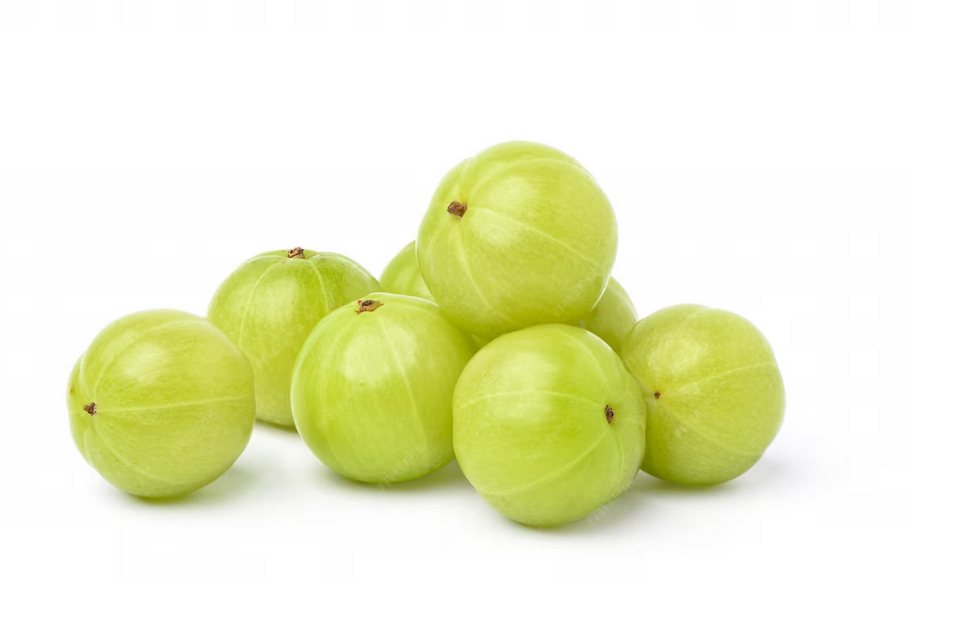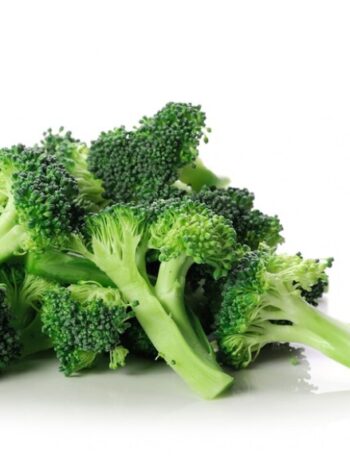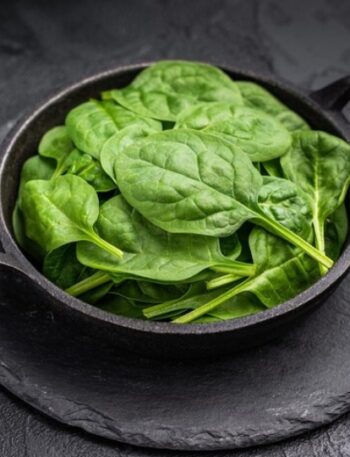Amla: The Ancient Superfruit of India. Commonly known as Indian gooseberry, Amla is a small green fruit that holds a remarkable place in India’s cultural, culinary, and agricultural landscape. Scientifically known as Phyllanthus emblica or Emblica officinalis, amla is often hailed as a powerhouse of nutrients, but its significance goes far beyond its nutritional profile. It is deeply woven into the fabric of Indian heritage, revered in Ayurveda, cherished in traditional cuisine, and increasingly celebrated worldwide for its versatility and rich legacy.
Botanical Profile and Physical Characteristics
Amla grows on a medium-sized deciduous tree that can reach a height of 8 to 18 meters. The tree has a crooked trunk with spreading branches and small, simple leaves that resemble pinnate foliage. The fruits are round, light green to yellowish in color, smooth-skinned, and about the size of a golf ball. Each fruit typically contains six vertical grooves and a fibrous, juicy pulp surrounding a hard seed.
The taste of amla is striking and unique—intensely sour, astringent, and slightly bitter, often followed by a subtle sweetness. This complex flavor profile makes amla stand out among other fruits and contributes to its distinctive role in food and traditional remedies.
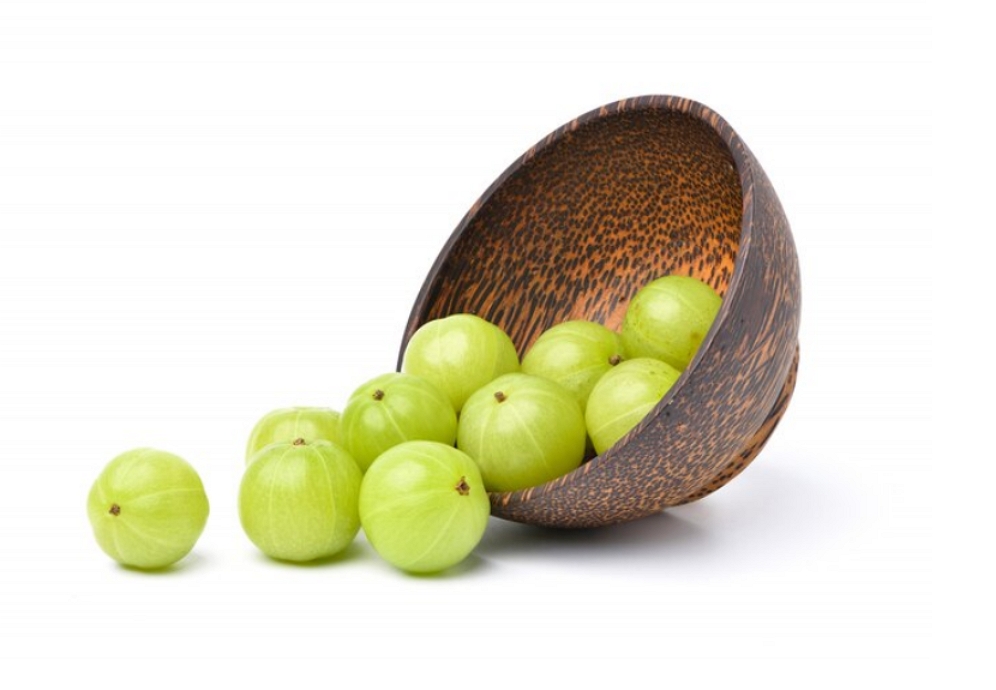
Geographical Origin and Cultivation
Amla is indigenous to the Indian subcontinent and grows widely in tropical and subtropical regions. It thrives in various parts of India, particularly in states like Uttar Pradesh, Madhya Pradesh, Rajasthan, Tamil Nadu, and Maharashtra. The tree is highly adaptable and can tolerate a range of soil types and weather conditions, making it suitable for dryland farming and marginal lands.
Cultivation of amla usually begins in June-July with planting, and the fruit is harvested between October and February. The trees begin fruiting in the third year and can yield fruit for decades. Amla farming has gained popularity not only for its resilience but also due to increasing demand in the food, cosmetic, and wellness industries.
Cultural and Historical Significance
The importance of amla in Indian culture is both spiritual and medicinal. In Hindu mythology, the amla tree is considered sacred and associated with Lord Vishnu. Amla is especially honored during the religious festival of Amla Navami, when the tree is worshipped for its divine properties. Ancient scriptures describe amla as a “divine fruit” that originated from the drops of Amrit (the elixir of immortality) spilled on earth during the churning of the ocean (Samudra Manthan).
Historically, amla has been mentioned in classical Ayurvedic texts such as the Charaka Samhita and Sushruta Samhita, where it is described as a rasayana—a substance that promotes longevity and rejuvenation. Its use spans thousands of years in traditional Indian medicine, and it remains a cornerstone ingredient in various Ayurvedic formulations.
Culinary Uses and Traditional Preparations
Despite its intense sourness, amla is widely consumed in Indian households in a variety of forms. It is used both fresh and processed, and its unique flavor lends itself to both sweet and savory dishes.
Some of the most popular culinary uses of amla include:
- Pickles (Amla Achar): Spiced amla pickles are a staple in Indian kitchens and are made with mustard oil, chilies, and a blend of traditional spices.
- Murabba: A sweet preserve made by soaking amla in sugar syrup, often enjoyed as a digestive or a dessert-like treat.
- Chutneys and Pastes: Amla is blended with herbs, spices, and green chilies to create tangy and flavorful condiments.
- Juices and Sherbets: Fresh amla juice, often consumed with a dash of salt or honey, is popular for its refreshing taste and presumed wellness properties.
- Candy and Dried Snacks: Dried and sweetened amla pieces are common as a chewy snack, especially among children and travelers.
- Powdered Amla: Dried amla is ground into a fine powder and used as a seasoning or supplement in various dishes and drinks.
In regional cuisines, especially in South India, amla is used in rice dishes and lentil-based recipes. It is also incorporated into fermented preparations and beverages.
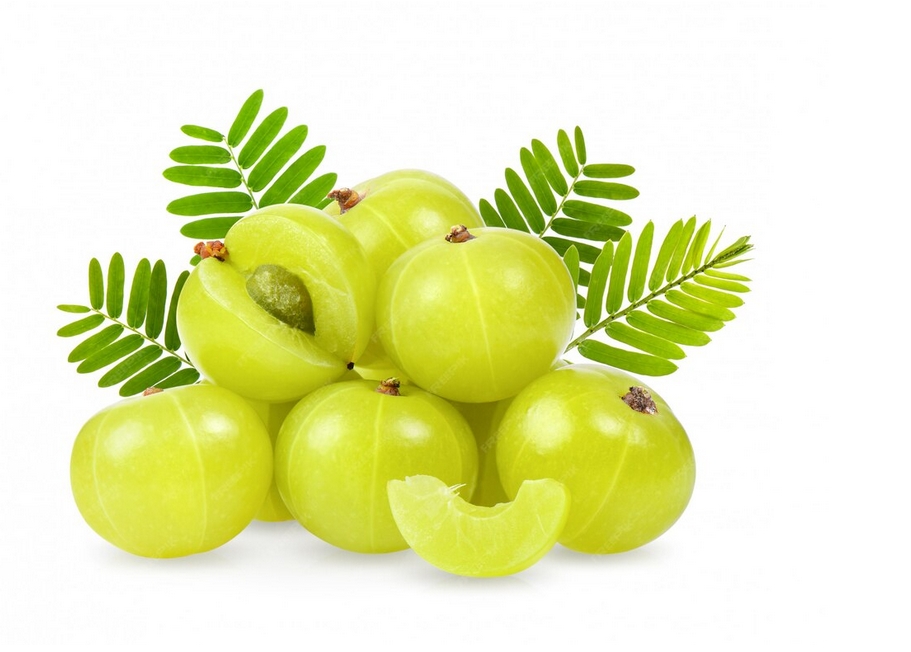
Role in Ayurveda and Traditional Systems
Amla holds an unparalleled place in Ayurveda. It is classified as a tridoshic fruit, meaning it helps balance all three doshas—Vata, Pitta, and Kapha. Its five of six tastes (excluding salt) make it unique in Ayurvedic dietary science, as very few substances are so well-rounded in taste and energy.
Amla is one of the primary ingredients in Chyawanprash, a traditional herbal jam consumed for energy, immunity, and vitality. It is also used in herbal oils, tonics, and rejuvenative treatments for the skin, hair, and internal systems. Ayurveda recognizes amla as a potent rasayana for strengthening the body’s defense mechanisms, nourishing tissues, and enhancing longevity.
Beyond Ayurveda, amla is used in Unani, Siddha, and Traditional Chinese Medicine, where it is valued for its cooling, detoxifying, and revitalizing properties.
Cosmetic and Industrial Uses
Amla is a popular ingredient in the cosmetic and personal care industry, especially in hair care products. Amla oil is traditionally massaged into the scalp to promote hair growth, prevent premature graying, and improve hair strength and luster. Many shampoos, conditioners, and hair masks now include amla extract for these reasons.
In skincare, amla is used in face masks, creams, and anti-aging products due to its natural astringency and high vitamin C content. Additionally, the fruit extract is used as a natural preservative and antioxidant in various cosmetic formulations.
Industrially, amla is used in the production of natural dyes, inks, and even tanning agents. Its versatility makes it a valuable agricultural product with economic potential beyond food and health sectors.
Global Expansion and Market Demand
In recent years, amla has gained recognition outside of India, thanks to the growing global interest in traditional remedies and plant-based wellness solutions. It is now available in international markets in the form of powders, capsules, juices, extracts, and dried snacks.
Countries like the United States, Canada, Australia, and parts of Europe have seen increased availability of amla products, often sold in health food stores and online platforms. The rise of yoga, Ayurveda, and holistic health movements has further fueled demand for amla as a superfruit.
India remains the largest producer and exporter of amla, and the global amla market is expected to grow steadily due to rising awareness about natural and preventive health practices.
Environmental and Agricultural Benefits
Amla cultivation is not only economically beneficial but also environmentally sustainable. The tree requires minimal maintenance, resists pests, and can thrive in less fertile soils. Its extensive root system helps prevent soil erosion, making it suitable for agroforestry and reforestation projects. Additionally, amla farming provides livelihoods to rural communities and supports eco-friendly agricultural practices.
Efforts are being made to encourage organic and sustainable amla cultivation, especially as consumer preference shifts toward clean and ethically sourced products.
Conclusion
Amla is more than just a fruit—it is a cultural emblem, a medicinal marvel, and a culinary delight. From the pages of ancient scriptures to modern-day supermarket shelves, amla’s journey reflects its resilience, versatility, and enduring appeal. Its place in Indian traditions remains unwavering, while its popularity in the global wellness community continues to grow. As people around the world seek natural, time-tested solutions for food and health, amla stands out as a shining example of the power of nature’s bounty.
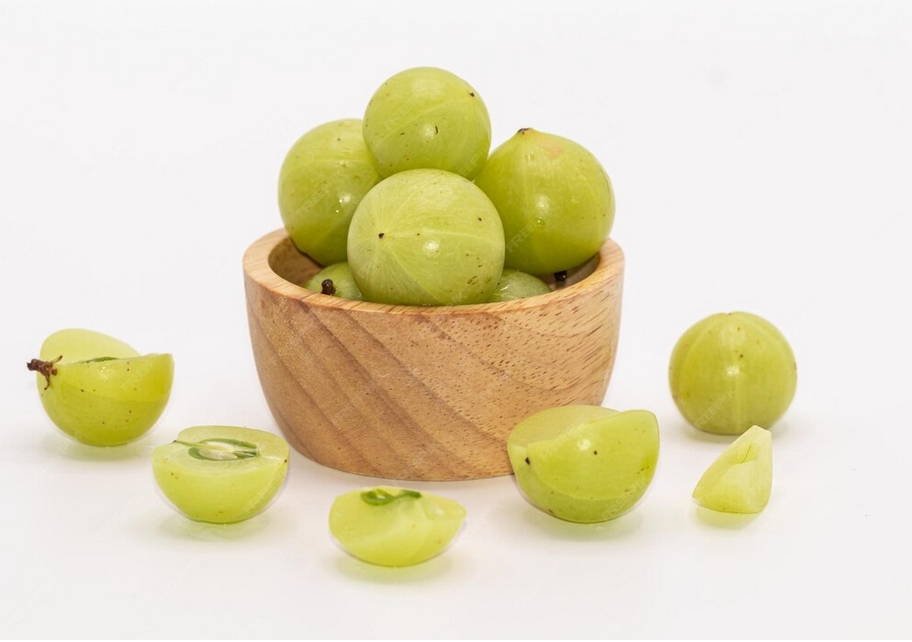
Health Benefits of Amla (Indian Gooseberry)
1. Boosts Immunity
Amla is exceptionally rich in vitamin C, which plays a critical role in strengthening the immune system. One small fruit contains more vitamin C than an orange, helping the body fend off infections by enhancing the production of white blood cells. Additionally, its antioxidant properties help neutralize free radicals, which can otherwise weaken the immune response. Regular consumption of amla can support the body’s natural defenses against common colds, flu, and various infections.
2. Enhances Digestive Health
Amla is known to promote better digestion by stimulating the secretion of gastric juices and supporting liver function. Its high fiber content helps regulate bowel movements, relieve constipation, and cleanse the colon. Amla’s slightly sour and astringent taste can also balance stomach acids, making it effective in managing acidity and indigestion. Ayurvedic practices often include amla for its ability to rekindle the digestive fire, or Agni.
3. Improves Skin Health
The vitamin C and antioxidants in amla help in collagen production, which is essential for maintaining youthful, firm, and elastic skin. It helps combat skin aging by reducing wrinkles, fine lines, and pigmentation. Amla’s antibacterial and anti-inflammatory properties also help in treating acne, blemishes, and other skin irritations. Consumed regularly or applied topically, amla gives the skin a natural glow and enhances its texture.
4. Promotes Hair Growth
Amla is a well-known remedy for improving hair health. It nourishes the scalp, strengthens hair roots, and promotes hair growth. The antioxidants and vitamins in amla help in reducing hair fall, delaying premature graying, and treating dandruff. Traditionally, amla oil or powder is applied directly to the scalp, while internal consumption of fresh or dried amla boosts overall hair vitality from within.
5. Regulates Blood Sugar Levels
Amla contains chromium, a mineral that enhances insulin sensitivity and helps regulate blood sugar levels. It slows the absorption of sugar into the bloodstream, preventing sudden spikes and crashes. This makes amla particularly beneficial for people with diabetes or those at risk. Studies suggest that regular intake of amla can help control fasting and post-meal blood sugar levels effectively.
6. Supports Heart Health
The antioxidants, fiber, and vitamin C in amla work together to improve cardiovascular function. Amla helps reduce bad cholesterol (LDL) and triglycerides while increasing good cholesterol (HDL). It also prevents the buildup of plaque in arteries, thus reducing the risk of atherosclerosis and heart attacks. Additionally, its anti-inflammatory properties help in maintaining healthy blood vessels and controlling high blood pressure.
7. Enhances Liver Function
Amla supports the liver’s natural detoxification process by flushing out toxins and protecting liver cells from damage. It stimulates the production of bile, which aids in fat digestion, and enhances liver enzyme function. Studies suggest that amla has hepatoprotective properties, making it useful in preventing liver disorders caused by alcohol, poor diet, or medication. Amla’s antioxidant capacity shields the liver from oxidative stress.
8. Aids in Weight Management
Amla can assist in weight loss by improving metabolism and aiding digestion. It enhances nutrient absorption, reduces hunger pangs, and helps in the efficient breakdown of food. Its high fiber content promotes satiety, making you feel fuller for longer. Amla juice or powder consumed before meals can help curb appetite naturally, thus supporting a healthy weight management routine.
9. Improves Eye Health
Amla is traditionally used to support vision and maintain eye health. Its rich vitamin C and carotene content help improve visual acuity, reduce eye strain, and protect against age-related macular degeneration and cataracts. Regular consumption of amla helps prevent eye infections, dryness, and irritation, thanks to its antibacterial and anti-inflammatory effects.
10. Acts as a Natural Detoxifier
Amla helps in detoxifying the blood and organs by flushing out harmful toxins and heavy metals from the body. It promotes healthy kidney and liver function, supports lymphatic drainage, and enhances skin clarity through internal cleansing. Amla’s diuretic nature increases urine production, which helps remove waste efficiently. This makes it a valuable addition to detox diets or seasonal cleanses.
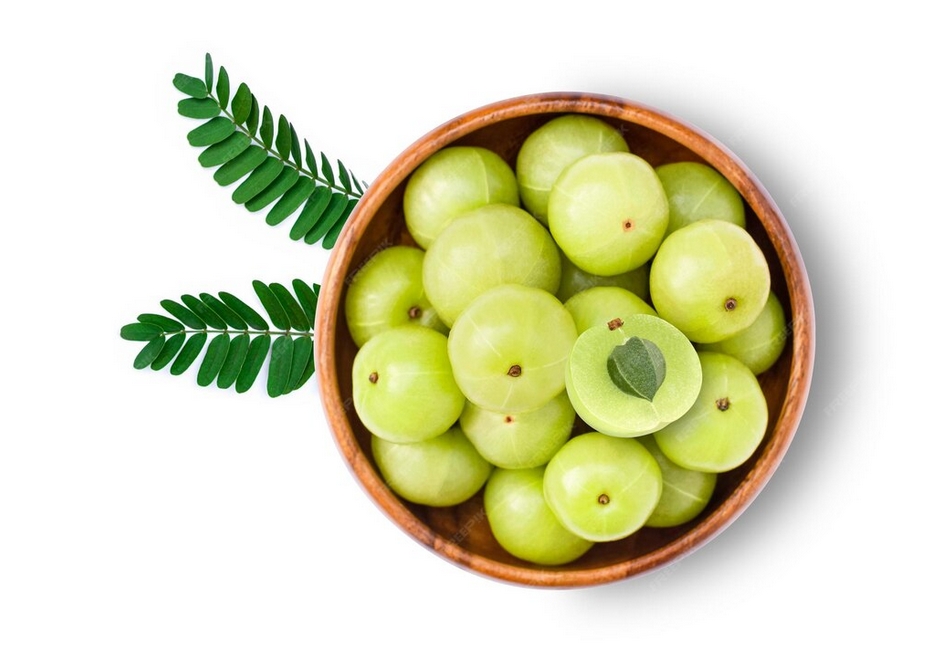
Frequently Asked Questions (FAQs) about Amla (Indian Gooseberry)
1. What is Amla?
Amla, also known as Indian gooseberry, is a small green fruit that comes from the Phyllanthus emblica tree, native to the Indian subcontinent. It has a distinctive sour and astringent taste and is highly valued in Ayurveda for its medicinal and rejuvenating properties. Rich in vitamin C, antioxidants, and fiber, amla has been used for centuries in traditional medicine, cooking, and hair and skin care.
2. How is Amla commonly consumed?
Amla can be consumed in various forms depending on preference and availability. Fresh amla is eaten raw, juiced, or added to chutneys and salads. Dried amla is often sweetened and eaten as a snack. It is also processed into powders, capsules, candies, pickles, and syrups. Amla juice is especially popular for its detoxifying effects and is often consumed on an empty stomach for better results.
3. What does Amla taste like?
Amla has a unique taste that combines sourness, bitterness, and a slight sweetness that becomes more apparent after chewing. This complexity is due to its high vitamin C content and natural tannins. Some people find the taste strong and puckering, especially when eaten raw, while others enjoy it more when mixed with honey, salt, or other spices to balance the flavor.
4. Is Amla good for daily consumption?
Yes, amla is generally safe for daily consumption in moderate amounts. Regular intake can support overall health, including digestion, immunity, and skin wellness. However, consuming it in excess—especially in concentrated forms like supplements—may cause acidity or digestive upset in some individuals. One to two raw fruits per day or a small serving of juice or powder is typically considered safe and beneficial.
5. How should Amla be stored?
Fresh amla should be kept in a cool, dry place and preferably refrigerated to extend its shelf life, lasting up to 2–3 weeks. Dried or powdered amla should be stored in airtight containers away from sunlight and moisture. Amla preserves like murabba, pickles, or chutneys can last much longer if stored properly in sterilized containers. Amla juice should be refrigerated and consumed within a few days of opening.
6. Can Amla help improve hair health?
Yes, amla is widely recognized for its positive impact on hair health. It is rich in nutrients that strengthen hair follicles, promote hair growth, and reduce hair fall. It also helps delay premature graying and fights dandruff due to its antibacterial and anti-inflammatory properties. Amla oil is often massaged into the scalp, and powdered or juiced amla is consumed internally to nourish hair from within.
7. Is Amla safe during pregnancy?
Amla is generally considered safe for pregnant women when consumed in moderate food-based amounts. Its high vitamin C and iron content can be beneficial for immunity and anemia prevention. However, some women may experience acidity or digestive discomfort due to amla’s sourness. It’s best to consult a healthcare provider before adding amla to your diet during pregnancy, especially in supplement form.
8. Can Amla be used for weight loss?
Yes, amla can be a helpful addition to a weight loss regimen. It boosts metabolism, aids digestion, and helps control appetite. Drinking amla juice or taking amla powder with warm water before meals can support fat burning and reduce cravings. Its high fiber content promotes satiety, helping you feel full longer and consume fewer calories throughout the day.
9. Does Amla have any side effects?
While amla is generally safe, consuming it in large quantities can lead to some side effects like acidity, diarrhea, or upset stomach—especially in people with sensitive digestive systems. Those with kidney disorders should also consult a doctor before taking large amounts, as amla is rich in oxalates, which may aggravate kidney stone issues. As with any natural remedy, moderation and balance are key.
10. How is Amla used in Ayurveda?
In Ayurveda, amla is considered a “rasayana,” meaning a rejuvenator that promotes vitality and longevity. It is used to balance all three doshas—Vata, Pitta, and Kapha—and is a key ingredient in formulations like Chyawanprash, Triphala, and Brahma Rasayana. Amla is used to treat a variety of conditions, from respiratory issues and digestive disorders to skin problems and chronic fatigue. Its versatility and balancing nature make it a cornerstone of Ayurvedic healing.

